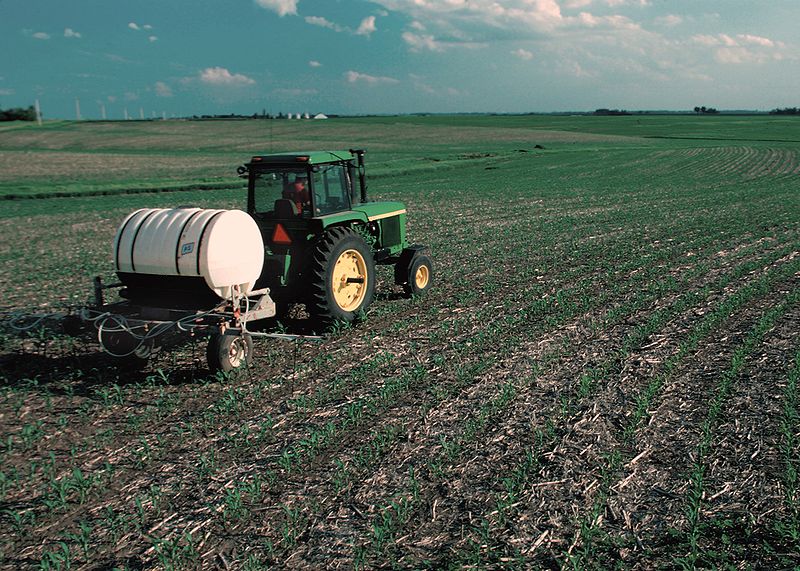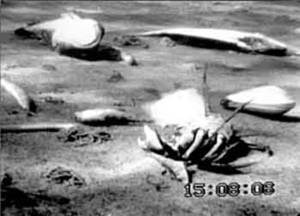Not Enough Nitrogen to Feed the World
Interview with
Chris - Finally, to the most abundant stuff in the atmosphere, nitrogen, and why turning it into fertiliser to feed a growing population is also a recipe for trouble. Jim Galloway.
Jim - All life needs nitrogen in the form of amino acids. We get our amino acids by eating food. If we don't have amino acids, we can't survive, no other species can survive. And so the question is; where do you get your amino acids? One hundred years ago, there was enough nitrogen naturally occurring in the environment for humans to grow enough food. But in 1898, Sir William Crookes, the president of the British Association for the Advancement of Science, in his annual address, said to the assembled members that there was not enough nitrogen available to feed the civilised world. By "civilised world" I'm sure he meant the UK, maybe not the US at the time!
 Chris - Not the colonies...
Chris - Not the colonies...
Jim - Not the colonies! And so that was over 100 years ago, and it was just to set the stage for things to come, because we just didn't have enough nitrogen. That led to the invention of the Haber-Bosch process by Fritz Haber and Carl Bosch.
Chris - I think the world war could have helped there as well...
Jim - That's fascinating. Vaclav Smil has written an excellent book called "Enriching the Earth", MIT press, 2001, where he talks about Haber and Bosch and how their ardent nationalism for Germany really drove them to first invent the process and then scale it up to an industrial level where they could provide munitions for Germany because, of course, Germany was blockaded.
Chris - But this, of course, enabled them to make ammonia, which is the starting material for all of this fixed nitrogen, all of these fertilisers and other compounds we want to make from nitrogen. That meant the farmers could then begin to put the stuff on the soil. But therein the rot has set in since, because now we're in a position where we're putting tonnes of the stuff all over the place.
Jim - Yes, you're absolutely right, the Haber-Bosch process converts N2, two nitrogen atoms stuck together in the atmosphere, into ammonia. It is then used for fertiliser, it's used for some other things too - like bombs - but mostly fertiliser. We needed it because there's too many people eating too high up the food chain to use just natural sources of nitrogen. Now, we're making about one hundred million metric tonnes of nitrogen fertiliser a year, globally. The good news is it's feeding a large percent of the world's population. The bad news is that much of it, some would say most of it, is lost to the environment after the food production process. This is contributing to smog, to acid deposition, to global change, to dead zones on the coast, to stratospheric ozone depletion... A list of environmental issues all connected together because literally one atom of nitrogen put in the atmosphere, made active by humans, will contribute to all of those problems, in sequence - It's called the nitrogen cascade.
Chris - So, of the amount of nitrogen we put onto a field, how much actually goes into the plant and therefore into my mouth, and your mouth, and how much doesn't? What fraction goes in each direction?
Jim - If you're a vegetarian, then the amount of nitrogen that is applied, about 20% would get into your mouth.
Chris - Gosh, 80% goes into all these other areas, it causes seas to have dead zones and so on - that's a worry.
 Jim - And if you only eat meat, it's around 10% that goes into your mouth. The other 90% is lost during the food production process. That's a major issue, and there's various points along the food production pathway where nitrogen is lost. Also, there are points along the food production pathway where you can control the losses. So this is not just a bad news/bad news story - this is a story that's sying "we need to take some action here." There are places where we can take effective action, and this should be done not just in the developed world, but also especially in the developing world.
Jim - And if you only eat meat, it's around 10% that goes into your mouth. The other 90% is lost during the food production process. That's a major issue, and there's various points along the food production pathway where nitrogen is lost. Also, there are points along the food production pathway where you can control the losses. So this is not just a bad news/bad news story - this is a story that's sying "we need to take some action here." There are places where we can take effective action, and this should be done not just in the developed world, but also especially in the developing world.
Chris - Do you think it's going to be effective to go up to people in Indonesia and China and say "you can't use all this fertiliser because this will be the onward consequence for the environment". We haven't got much evidence that they really care about the environment now, so why should they care about this?
Jim - Let me break that question up into two parts: For the developed countries, I think there's a strong foundation of environmental awareness that either exists or can be built upon; For the developing countries, you can tie directly the losses of nitrogen to the environment of those countries, to decreased ability to grow food, and decreased ability to use their coastal zones to raise biomass. And so, I think showing people that "if you don't control nitrogen issues, your air is going to get worse, you're going to have huge human health impacts, increased losses of nitrogen in the coastal zones, and it's going to impact the very fabric of your human ecological health.
Chris - So, what could the average person do to make the biggest inroads to reducing their nitrogen footprint like this?
Jim - The first is to eat only the protein that you need. The USDA recommended level is 3kg of nitrogen per person per year, the average American eats about 5kg. And so, just by decreasing that 5 down to 3 - smaller portions of steak, one egg instead of two eggs - it's not rocket science, as they say - that would decrease the amount of nitrogen lost in the United States by almost 50%.










Comments
Add a comment